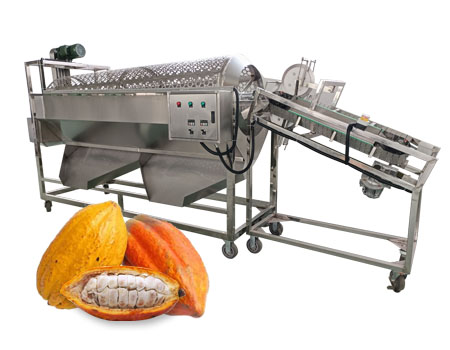How is the raw material for cocoa beans processed?
The large egg-shaped cocoa pods wrapped around the outside of cocoa beans are also called cocoa nuts. Cocoa beans are the seeds in the cocoa pods, the fruit of the cacao tree, and each cocoa pod contains about 20-40 cocoa beans. Cocoa beans are ground and pressed into cocoa powder, which is the main raw material for chocolate. The following are the main steps in the processing of raw cocoa beans:
1, Harvesting and drying
Picking: Cocoa beans are the seeds from the fruit picked from the cocoa tree. Collectors will work alongside the pickers to gather the pods into baskets and transport them to the edge of the field.
Crushing: Traditionally, workers use a machete to split the wooden shell of the pods to open the pods, and then the pods are hammered so that the beans fall out intact, but this efficiency is slow, and in modern times they are crushed and separated by machines.

Drying: Drying is done to remove moisture and impurities from the surface of the cocoa beans and to promote the fermentation of the beans. The drying process usually takes place in sunlight, but fire or other heat sources can also be used for drying. The drying time depends on weather conditions and the moisture content of the cocoa beans, and usually takes 5 to 8 days.
2, Fermentation
Fermentation process: After drying, cocoa beans are fermented, which is a key step in the processing of cocoa beans. The fermentation process helps to remove bitterness and impurities from the beans, and also helps to develop the unique flavor of the beans. Fermentation time varies depending on the variety, the needs of the finished product, and the habits of the farmer or cooperative, with an average time of about 5 to 6 days and a maximum of 7 days. The fermentation temperature usually does not exceed 50°C.
Fermentation: During fermentation, the sugars in the cocoa beans are converted into acids (mainly lactic and acetic), while complex biochemical changes are produced that enhance aroma and flavor. Fermentation also causes the temperature of the beans to rise, killing the bacteria in them and activating the enzymes present to form the mixture that produces the chocolate flavor when the beans are roasted.
3, Roasting
Purpose of roasting: After drying and fermenting, cocoa beans need to be roasted to further remove moisture and add flavor to the beans. Roasting can also make the cocoa beans darker in color, and make its surface form a layer of gloss.
Roasting conditions: Roasting temperatures usually range between 110130°C and times between 20-60 minutes. Roasting temperature and time affect the flavor and color of cocoa beans.
4, Grinding
Grinding process: After roasting, cocoa beans need to be ground to make cocoa paste with fine cocoa texture. The grinding process separates the fats and solids in the cocoa beans to form cocoa solids and cocoa butter.

Grinding equipment: Cocoa beans are usually poured into a grinder, where they are continuously ground and heated, resulting in a fine-textured cocoa paste.
5, Separation and refining
Separation: Cocoa solids and cocoa butter can be further separated. Cocoa solids can be filtered and pressed to make cocoa powder, while cocoa butter can be extracted and refined through cold pressing and chemical separation.
Refining: The refining process aims to improve the quality and purity of cocoa powder and cocoa butter.
6, Mixing and blending
Mixing: Cocoa solids, cocoa butter and other ingredients (e.g. sugar, dairy products, etc.) can be mixed and blended according to different recipes.
Modulation: According to different tastes and needs, other ingredients such as vanilla and nuts can be added to increase the flavor of chocolate. After mixing, the chocolate is refined to remove the particles and ensure a smoother texture and better taste.
